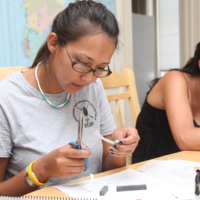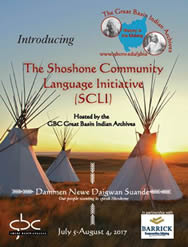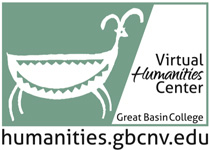Browse Exhibits (2 total)
Great Basin Indian Archives @ VHC



The Great Basin Indian Archives @ VHC is a collaborative digital exhibition of Western Shoshone oral histories, language and cultural resources to help revitalize the Western Shoshoni language and preserve the living culture.
Defining Native Americans:
The Blood Quantum Issue
GBC Talks: “Defining Native Americans: The Blood Quantum Issue” discusses what and how “Blood Quantum” is defined, which is a very popular yet highly controversial topic amongst Native Americans. The three panelists each discuss significant factors that impact how blood quantums have transformed over time and now influence membership policies for tribes.
Panelists include Dr. Scott A. Gavorsky (History Professor, Great Basin College), Jens Camp (Research Associate, Great Basin Institute and California Trail Interpretative Center), and James Hedrick (Cultural Manager, Newe Ghani Cultural Center).
KNPR's "State of Nevada" Show Discusses SCLI
 The Great Basin Indian Archives (GBIA) director Norm Cavanaugh recently discussed how the Shoshone Community Language Initiative (SCLI) is helping revitalize the Western Shoshoni language on KNPR's "State of Nevada" radio program. Joining Norm was the VHC's Scott Gavorsky to discuss the GBIA Elder Oral History Project.
The Great Basin Indian Archives (GBIA) director Norm Cavanaugh recently discussed how the Shoshone Community Language Initiative (SCLI) is helping revitalize the Western Shoshoni language on KNPR's "State of Nevada" radio program. Joining Norm was the VHC's Scott Gavorsky to discuss the GBIA Elder Oral History Project.
Listen to "Saving the Western Shoshone Language," courtesy of KNPR [external link]
In addition to students from Western Shoshone communities of Nevada and Idaho, SCLI 2017 welcomed students from New Jersey, Oregon, and California.
Semahte Wahatte man To'ainkanna (Twelve)
If you missed Semahte Wahatte man To'ainkanna (Twelve), a traditional tale of the seasons and months as performed by the 2014 SYLAP students, we are proud to present it here:
Video courtesy of the the University of Utah Shoshoni Language Project.
Event, Live Streaming, and Digital Archiving Made Possible by the Generous Support of

Any views, findings, conclusions, or recommendations expressed do not necessarily represent those of the National Endowment for the Humanities, Barrick Gold North America, or Great Basin College.
Elkokoak: The Basques of Elko


The Virtual Humanities Center at Great Basin College is proud to present this growing collection of materials representing northeastern Nevada's rich Basque heritage. Originally designed in conjunction with the 2016 Smithsonian Folklife Festival "Innovation by Culture" tribute to Basque-Americans and the Elko National Basque Festival, the Elkokoak exhibit will be a permanent showcase of our local Basque communities.
"Basques and Buckaroos": 34th National Cowboy Poetry Gathering to Honor Basque Culture in the West
The 34th National Cowboy Poetry Gathering will highlight special guests and programming honoring the contemporary heritage of Basques and Buckaroos. Often one in the same, many Basques came to the American West to work on sheep and cattle ranches as herders and buckaroos. Today, many Basque families successfully own and operate their own ranches and carry rich stories of immigration and adaptation. Among Basque communities overseas and in the American West, traditions of music, improvised poetry, literature, dance, foodways and more are flourishing.
The Gathering will be 29 January through 3 February 2018 in Elko, NV. For the full schedule and ticketing, visit the Western Folklife Center page.
The "Elkokoak: The Basques of Elko" Exhibit is a joint project of
This exhibit has been made possible in part by a major grant from the National Endowment for the Humanities: Exploring the human endeavor
Any views, findings, conclusions, or recommendations expressed in this exhibit do not necessarily represent those of the National Endowment for the Humanities.


